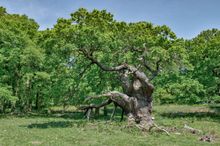 22 Jul 2025
22 Jul 2025
Tags: ancient trees, National Forest, environment

Ancient trees are among the most valuable natural and cultural assets in the British landscape. Defined not simply by age, but by specific biological and structural features, these trees are irreplaceable habitats for wildlife and living links to the nation's history.
In the National Forest, a 200-square mile regeneration project spanning parts of Derbyshire, Leicestershire and Staffordshire, ancient trees play a vital but often overlooked role in connecting past and future landscapes.
Based on current data from the Woodland Trust's Ancient Tree Inventory, there are approximately 1,040 of these ancient trees recorded within the National Forest.
The recent illegal felling of the iconic Sycamore Gap Tree in 2023 has brought national attention to the vulnerability of ancient trees and the urgent need to protect these irreplaceable natural and cultural assets.
A tree is only considered ancient when it is exceptionally old for its species and shows distinct signs of ageing, such as a hollowing trunk, broad girth, large and spreading branches, and areas of deadwood or decay.
Age thresholds vary depending on species. An oak tree may be regarded as ancient from around 400 years, while a yew might only reach that classification after 800 years or more.
These trees are typically found in environments where they have grown undisturbed for centuries, including churchyards, parkland, hedgerows and old wood-pasture.
The most frequently recorded ancient tree species is the pedunculate oak (Quercus robur), a long-lived native species often found in old hedgerows and estate landscapes.
Sweet chestnut (Castanea sativa) is also common, particularly in older parkland, where it may display ancient features at a comparatively younger age.
One such tree now enjoying national attention is Bradgate Park's oldest oak, an extraordinary English oak believed to be around 825 years old, with a girth of 8.57 metres.
Situated just metres from the ruins of Bradgate House, the tree would already have been an impressive veteran when Lady Jane Grey was born there in 1537.
It is likely she saw the tree from the windows of the Tudor mansion and may even have played beneath its boughs during her childhood.
Lady Jane Grey holds the unfortunate record of the shortest reigning monarch in British history, taking the throne for just nine days in July 1553 before being overthrown by Mary I and beheaded, aged 17.
With its immense, gnarled trunk now split into two and heavy branches supported by props, the tree is a powerful symbol of survival.
A local legend tells that Bradgate Park's oaks were cut back in mourning after Lady Jane's execution in 1554 and this ancient oak's lopped crown may lend some credence to the tale.
The tree has now been shortlisted in the Woodland Trust's Tree of the Year 2025 competition, which celebrates the UK's most inspiring trees and the stories behind them.
Ten trees from across the country have been selected by an expert panel, each recognised for their cultural importance, connection to place and role in local life.
The winning tree will go on to represent the UK in the European Tree of the Year contest.
Voting is open until 19 September. To view the shortlist and vote for Bradgate, visit www.woodlandtrust.org.uk/treeoftheyear
Another, among the many notable sites in the forest, is Calke Abbey, located in Ticknall, Derbyshire and managed by the National Trust.
This historic parkland is a must-visit for anyone interested in ancient trees, designated as a National Nature Reserve for its veteran trees and the deadwood invertebrates that they support.
The 1,000-year-old 'Old Man of Calke' may be the oldest in the grounds, but it is joined just metres away by another oak believed to be around 800 years old.
These trees are just the headline act. The wider parkland is rich with ancient and veteran trees, many of them hosting extensive deadwood habitats that support a wealth of wildlife.
There's also an ancient oak to be found at The Deer Park at Hoar Cross, where visitors walking the woodland footpath around the historic deer enclosure are treated to the sight of a particularly impressive ancient oak.
These ancient trees are vital for biodiversity, supporting a wide range of wildlife, including bats, fungi, lichens, birds and many invertebrates, that depend on the complex microhabitats created as the tree ages.
They also offer historical continuity, having stood witness to centuries of local change, often marking traditional boundaries or forming part of cultural landscapes that are still valued today.
Truly irreplaceable, their unique value cannot be restored within any human timescale once lost. While some benefit from conservation protections or tree preservation orders, many remain vulnerable to threats such as development, neglect or unsuitable management.
Identifying and safeguarding them is not only vital for biodiversity, but also for protecting the deep cultural and historical roots they represent.
Championing these trees is one way we can all contribute to a more resilient and ecologically rich landscape.
By supporting the work of the National Forest and becoming a Forest Champion, individuals can help ensure that these living monuments continue to be valued, protected and enjoyed for generations to come.
To find out more, or to become a Forest Champion, visit www.nationalforest.org

